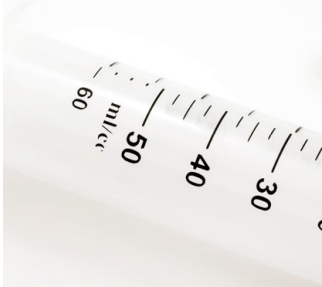
Syringes hold different volumes of solution, and this can be measured by graduation lines on the barrel. These lines may be measured in milliliters or smaller units, depending on the size of the syringe).
Milliliters (mL) are sometimes also referred to as cc’s (cubic centimeters). Smaller syringes such as Insulin syringes may be measured by units versus milliliters and some larger syringes are even measured by ounces.
The barrel of the syringe has a scale on it that tells us how much volume the syringe holds and the dosing measurements. Every syringe is different as far as the graduation marks. Most often, you will find syringes with graduation scales where the small lines represent either 2mL, 1mL, .1mL, or 0.01mL, depending on the size and brand of the syringe.
Larger syringes will include larger graduations because the volume is larger. Smaller syringes include smaller graduation marks since their volume is smaller. The syringe size that you choose to use for your application would depend on your desired volume.
For instance, you wouldn’t want to choose a 50mL syringe when your desired volume is .5cc. You would choose a syringe that is closest to the size of your desired volume. Syringes markings also vary by brand, size, and type.
Most of the time syringes that meet ISO standards have additional markings beyond the nominal capacity designated by the manufacturer. If the scale is extended beyond the nominal capacity line, the extension is typically differentiated from the rest of the scale.
Smaller volume syringes typically do not extend past their designated volume, but as syringes increase in size, the amount that the syringe is graduated to past their standard capacity often increases as well.
Not every syringe, nor every manufacturer provides the extended scale. Per ISO 7886-1, the only requirement is to mark the nominal capacity, not the maximum usable capacity. Below are some common sizes which tend to offer extended volume scales.
Depending on country, industry, or application, the syringe may be referred to as either the volume it is standardized to, or as the volume that the extended graduation marks reach. For instance, a syringe that is most often referred to as a 3mL syringe in the United States is considered a 2mL syringe in Europe. See below for examples.
 |
This is a 2mL by ISO standards, but graduated (scaled) to 3mL. In the US, this is commonly referred to as a 3 milliliter syringe. In Europe they most often refer to this as a 2mL. |
|
This is a 20mL syringe per ISO 7886-1, but can be referred to as a 20mL or a 25mL syringe. |
 |
 |
This is a 50mL syringe with graduations extended to 60mL and commonly listed as a 60mL syringe. |
At Air-Tite, we carry a wide variety of syringe options. Below is a breakdown of the different syringe brands, size ranges, and options that we carry for human use.
If you have any questions about which syringe might be best for you, please give us a call and we can help you find a solution. Keep in mind most of our product options are available through a wide range of distribution partners. Please reach out to us for more information or click below to see our wide inventory.